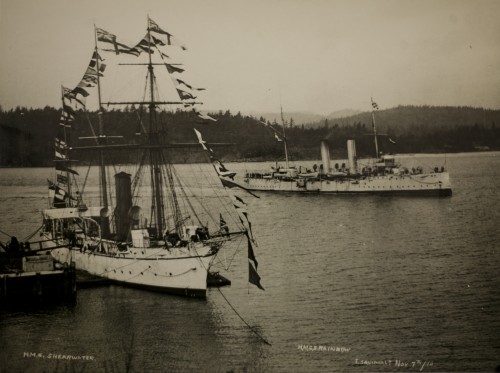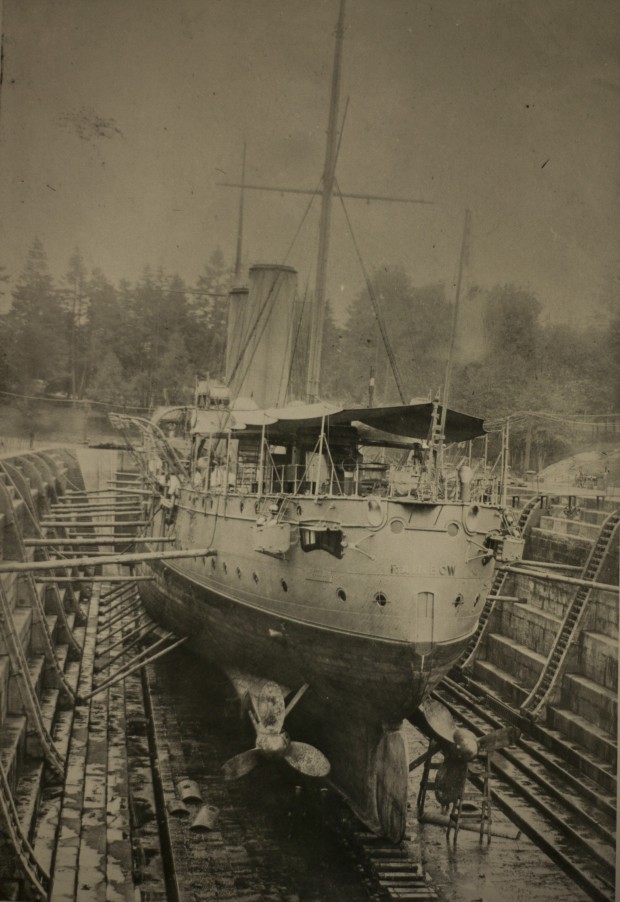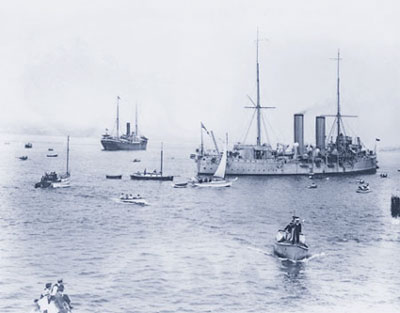The Naval Service of Canada and the Rainbow’s Beginnings
On the 5th of May, 1910, the Naval Service of Canada was officially legislated into existence.[1] Thus ended a long debate within Canada of whether or not a dominion run and serviced navy was a plausible entity. Immediately after its inception, the government of Wilfred Laurier set about creating a navy which could provide its own officers, ratings, and ships.[2] Ships were required to train crew on, and Canada lacked the means to convert or produce any. For this purpose, two old cruisers were purchased from the British Navy, the Niobe and the Rainbow.[3] Within time, Laurier planned to have ships built in Canada to serve on, but for now, these two ships would have to do. The Niobe, A relatively large and still powerful cruiser, was scheduled for service on the Eastern coast of Canada.[4] The Rainbow was to serve as a training ship operating out of Esquimalt Naval Base on Vancouver Island.
The Rainbow was originally launched in on March 25th, 1891.[5] An Apollo Class cruiser, she was commissioned into the Canadian Navy on the 4th of August, 1910, and ordered to sail from England to Esquimalt to report for duty. These were the first orders ever given to a warship by Canadian naval authority.[6] After a tumultuous 15,000 mile journey around Cape Horn, on which she was nearly swamped in high seas on numerous times, she reached Esquimalt on the November 8th.[7] Arriving fully dressed in flags and regalia, she fired off a 21 gun salute and prepared to receive “distinguished guests.”[8] The Canadian Naval Service had officially come to British Columbia.
British Columbia Welcomes the Rainbow

Although she was just a training ship, the Rainbow was received enthusiastically by Victorians. Feeling isolated and vulnerable at the far edge of the Empire, any ship was a good ship to them.[9] The day after arrival at Esquimalt, the Victoria Colonist announced “History was made at Esquimalt Yesterday. H.M.C.S. Rainbow came: and a new navy was born. Canada’s blue ensign flies for the first time on the Dominion’s own fighting ship in the Pacific.”[10] The paper took a measured approach and admitted that “the Rainbow is not a fighting ship,” however, “she is manned by fighting men, and her mission is to train men so as to make them fit to defend our country from invasion, protect our commerce on the seas and maintain the dignity of the Empire everywhere.”[11] The first speaker at the ships reception opined this was the most momentous moment in Canadian history since confederation.[12] The Victoria Times welcomed the Rainbow as a sign of things to come; the ship was “the necessary forerunner of the larger vessels which will add dignity to our name and prestige to our actions.”[13] Victoria gushed at the arrival of what many British Columbians saw as the start of a powerful navy.
After the reception in Victoria, the Rainbow made a port call at Vancouver. The ship was greeted just as warmly as in Victoria.[14] Almost immediately, the Rainbow picked up volunteers for training and began to cruise the British Columbia coastline.[15] On March 13th, 1911, the Premier of the province and the Lieutenant Governor gifted the ship a new set of armoured plate, and the Rainbow entertained an entourage of the public.[16] During the next year and a half of cruising, she was in constant demand to make ports of call to participate in ceremonies in her honour.[17] Kept busy training, visiting, and chasing poachers out of Canadian waters, was much celebrated and beloved by the people of British Columbia.
A ‘Heartbreaking Starvation Time’

Photo source: Maritime Museum of British Columbia
Despite the positive response to the naval presence on the West Coast, politics would hinder the growth of the Royal Canadian Navy. In September of 1911, a newly elected conservative government under Robert Borden completely rejected the fleet that Laurier’s liberals had built.[18] Borden favoured scrapping the Naval Service of Canada, and financing battleships for the Royal Navy which would be expected protect Canada’s shores.[19] According to Canadian naval historian Marc Milner, “in the three years before the outbreak of the First World War, there was no clear Canadian naval policy, and by 1914, almost no Canadian navy at all.”[20] The debates over whether to scrap the service entirely; to retain a small fleet of civilian armed ships; or to maintain a fleet of light cruisers; waged back and forth as Borden tried to appease his party’s and the British Admiralty’s (with Winston Churchill as First Sea Lord), demands.[21] Canadian men and boys who wished to volunteer for Canada’s navy were often advised to “join a real one,” and pointed towards the Imperial Navy.[22] For all and intents and purposes, it looked like the experiment of the Canadian Naval Service was a failure. Laurier’s dream of Canadian men trained at home and fighting on Canadian made ships was on the verge of being a lost one.
This was. according to Walter Hose then commander of the Rainbow, “a heartbreaking starvation time.”[23] The Canadian Naval Service held on by a thread, as budget cuts took their toll on the manpower and resources available.[24] Rainbow may have been mothballed at this time, had not been so cheap to operate, and if not for British sailors who were on a pre-arranged five year loan from the Royal Navy.[25] From 1912 to 1914, she lay at harbour in Esquimalt, only going out for short cruises to run the engine and to train her skeleton crew.[26] On July 9th, the Rainbow was finally prepped for a three month sealing patrol. Her skeleton crew was augmented up by importing East coast sailors and crew from the idle Niobe.[27] As she was preparing for this voyage, an interesting event was developing in Vancouver in which the Rainbow was now in condition to intervene.
“Our Only Ammunition is Coal”: The Komagata Maru Incident
In May 1914, the Japanese ship the Komagata Maru entered Canada with nearly 400 passengers from India. They were banned from entry to the country by Canada’s “Continuous Journey” legislation;a thinly disguised anti-East Asian immigration policy. In the face of this, the Indian passengers seized the ship from the Japanese captain, and refused to leave the harbour. India was still a Crown Colony, which made these immigrants British subjects. Many of them were also Indian Army Veterans.[28] The ship stay put until July 19, when local police attempted to board the ship and remove the passengers.[29] They were met with “a storm of missiles which included lumps of coal,” which prompted the police to withdraw.[30] On July 18th, the Rainbow was instructed to offer assistance to the authorities in Vancouver; the offer was promptly accepted.[31] The Rainbow steamed from Vancouver that night, ready to offer whatever assistance might be necessary.

Upon its arrival the next morning, Comander Hose reported throngs of expectant crowds lined up “like a regatta day” to witness the Rainbow in action.[32] Apparently the public enthusiasm for the Rainbow had not died down in its absence. A special dispatch from the Globe and Mail spoke of the possibility “that bloodshed may occur before the mutineers are handcuffed,” and dramatically wondered if the Rainbow would survive “the fight with the Hindus.”[33] As the Rainbow circled the Komagata Maru, Hose reported “a grizzled veteran, late of the Indian Army, put the relieving touch of humour on the otherwise serious outlook by standing on the upper bridge of the ‘Komagata’ and semaphoring to the Rainbow— ‘Our only ammunition is coal’.”[34] Bloodshed would turn out not to be necessary. The mutiny crew of the Komagata settled an agreement for provisions, and a pilot for the ship was supplied from the Rainbow.[35] On July 23rd, Rainbow escorted the Komagata Maru out to the open seas. Thus ended, according to Marc Milner, “one of the most embarrassing incidents in Canadian history.”[36] Rainbow had succeeded in its mission and she ordered back to Esquimalt. The clouds of war were beginning to gather. The ship would soon have more to deal with than a ship of hapless immigrants.
The Eve of war
So it was on the eve of war with Germany in late July, 1914, the Rainbow lay in dry dock in Esquimalt.[37] She was the only ship in the Canadian Naval service on the entire Pacific Coast, and therefore the most powerful. She was outdated, undermanned, and outclassed by the modern German cruisers already reported to be lurking in the Pacific.[38] As she was being cleaned and re-fitted for sealing patrol, the Admiralty warned the Canadian Government to keep her at ready.[39] The Rainbow was now officially in charge of defending the West Coast until help from the Royal Navy could arrive. It was soon time for the wholly unprepared Canadian Naval Service to go to war.
Footnotes:
[1] F.V. Longstaff, Esquimalt Naval Base: A History of its Work and its Defences, (Victoria, B.C: distributors Victoria Book & Stationery Co, 1941): 65.
[2] Ibid.
[3] Ibid
[4] Ibid.
[5] Admiral Patrick Brock, “Rainbow 1891-1910,” in the Brock Files, Original documents in Maritime Museum of British Columbia, Victoria B.C., n.p.
[6] Duguid, 12.
[7] Marc Milner. Canada’s Navy: The First Century, (2nd ed ed. Toronto: University of Toronto Press, 2010) 20.
[8] Tucker, 147.
[9] Milner, Canada’s Navy: The First Century, 20.
[10] Colonist, Victoria, Nov. 8th, 1910.
[11] Ibid
[12] Ibid.
[13] Times, Victoria, Nov. 7th, 1910.
[14] Tucker, 148.
[15] Brock, N.P.
[16] Ibid.
[17] Ibid.
[18] Milner, Canada’s Navy: The First Century, 28.
[19] Ibid, 26.
[20] Ibid
[21] Ibid, 28.
[22] Ibid, 29.
[23] Ibid.
[24] Ibid
[25] Ibid.
[26] Tucker, 148.
[27] Ibid.
[28] Milner, 35
[29] Tucker, 149
[30] Ibid.
[31] Ibid.
[32] Ibid.
[33] “Army and Navy Prepare to Quell Hindus To-Day,” Globe and Mail, July 21st, 1914, 1.
[34] Tucker, 149.
[35] Ibid.
[36] Milner, 35.
[37] Longstaff, 73.
[38] Brock, n.p.
[39] Ibid.

